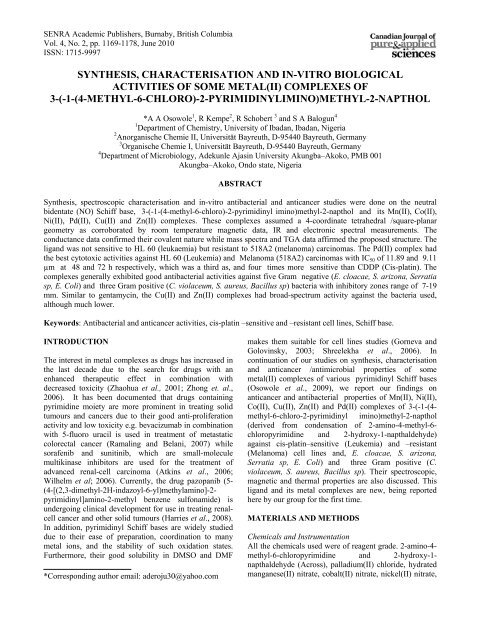Download (5Mb) - Covenant University Repository
Download (5Mb) - Covenant University Repository
Download (5Mb) - Covenant University Repository
You also want an ePaper? Increase the reach of your titles
YUMPU automatically turns print PDFs into web optimized ePapers that Google loves.
SENRA Academic Publishers, Burnaby, British Columbia<br />
Vol. 4, No. 2, pp. 1169-1178, June 2010<br />
ISSN: 1715-9997<br />
SYNTHESIS, CHARACTERISATION AND IN-VITRO BIOLOGICAL<br />
ACTIVITIES OF SOME METAL(II) COMPLEXES OF<br />
3-(-1-(4-METHYL-6-CHLORO)-2-PYRIMIDINYLIMINO)METHYL-2-NAPTHOL<br />
*A A Osowole 1 , R Kempe 2 , R Schobert 3 and S A Balogun 4<br />
1 Department of Chemistry, <strong>University</strong> of Ibadan, Ibadan, Nigeria<br />
2 Anorganische Chemie II, Universität Bayreuth, D-95440 Bayreuth, Germany<br />
3 Organische Chemie I, Universität Bayreuth, D-95440 Bayreuth, Germany<br />
4 Department of Microbiology, Adekunle Ajasin <strong>University</strong> Akungba–Akoko, PMB 001<br />
Akungba–Akoko, Ondo state, Nigeria<br />
ABSTRACT<br />
Synthesis, spectroscopic characterisation and in-vitro antibacterial and anticancer studies were done on the neutral<br />
bidentate (NO) Schiff base, 3-(-1-(4-methyl-6-chloro)-2-pyrimidinyl imino)methyl-2-napthol and its Mn(II), Co(II),<br />
Ni(II), Pd(II), Cu(II) and Zn(II) complexes. These complexes assumed a 4-coordinate tetrahedral /square-planar<br />
geometry as corroborated by room temperature magnetic data, IR and electronic spectral measurements. The<br />
conductance data confirmed their covalent nature while mass spectra and TGA data affirmed the proposed structure. The<br />
ligand was not sensitive to HL 60 (leukaemia) but resistant to 518A2 (melanoma) carcinomas. The Pd(II) complex had<br />
the best cytotoxic activities against HL 60 (Leukemia) and Melanoma (518A2) carcinomas with IC50 of 11.89 and 9.11<br />
µm at 48 and 72 h respectively, which was a third as, and four times more sensitive than CDDP (Cis-platin). The<br />
complexes generally exhibited good antibacterial activities against five Gram negative (E. cloacae, S. arizona, Serratia<br />
sp, E. Coli) and three Gram positive (C. violaceum, S. aureus, Bacillus sp) bacteria with inhibitory zones range of 7-19<br />
mm. Similar to gentamycin, the Cu(II) and Zn(II) complexes had broad-spectrum activity against the bacteria used,<br />
although much lower.<br />
Keywords: Antibacterial and anticancer activities, cis-platin –sensitive and –resistant cell lines, Schiff base.<br />
INTRODUCTION<br />
The interest in metal complexes as drugs has increased in<br />
the last decade due to the search for drugs with an<br />
enhanced therapeutic effect in combination with<br />
decreased toxicity (Zhaohua et al., 2001; Zhong et. al.,<br />
2006). It has been documented that drugs containing<br />
pyrimidine moiety are more prominent in treating solid<br />
tumours and cancers due to their good anti-proliferation<br />
activity and low toxicity e.g. bevacizumab in combination<br />
with 5-fluoro uracil is used in treatment of metastatic<br />
colorectal cancer (Ramaling and Belani, 2007) while<br />
sorafenib and sunitinib, which are small-molecule<br />
multikinase inhibitors are used for the treatment of<br />
advanced renal-cell carcinoma (Atkins et al., 2006;<br />
Wilhelm et al; 2006). Currently, the drug pazopanib (5-<br />
(4-[(2,3-dimethyl-2H-indazoyl-6-yl)methylamino]-2pyrimidinyl]amino-2-methyl<br />
benzene sulfonamide) is<br />
undergoing clinical development for use in treating renalcell<br />
cancer and other solid tumours (Harries et al., 2008).<br />
In addition, pyrimidinyl Schiff bases are widely studied<br />
due to their ease of preparation, coordination to many<br />
metal ions, and the stability of such oxidation states.<br />
Furthermore, their good solubility in DMSO and DMF<br />
*Corresponding author email: aderoju30@yahoo.com<br />
makes them suitable for cell lines studies (Gorneva and<br />
Golovinsky, 2003; Shreelekha et al., 2006). In<br />
continuation of our studies on synthesis, characterisation<br />
and anticancer /antimicrobial properties of some<br />
metal(II) complexes of various pyrimidinyl Schiff bases<br />
(Osowole et al., 2009), we report our findings on<br />
anticancer and antibacterial properties of Mn(II), Ni(II),<br />
Co(II), Cu(II), Zn(II) and Pd(II) complexes of 3-(-1-(4methyl-6-chloro-2-pyrimidinyl<br />
imino)methyl-2-napthol<br />
(derived from condensation of 2-amino-4-methyl-6chloropyrimidine<br />
and 2-hydroxy-1-napthaldehyde)<br />
against cis-platin–sensitive (Leukemia) and –resistant<br />
(Melanoma) cell lines and, E. cloacae, S. arizona,<br />
Serratia sp, E. Coli) and three Gram positive (C.<br />
violaceum, S. aureus, Bacillus sp). Their spectroscopic,<br />
magnetic and thermal properties are also discussed. This<br />
ligand and its metal complexes are new, being reported<br />
here by our group for the first time.<br />
MATERIALS AND METHODS<br />
Chemicals and Instrumentation<br />
All the chemicals used were of reagent grade. 2-amino-4methyl-6-chloropyrimidine<br />
and 2-hydroxy-1napthaldehyde<br />
(Across), palladium(II) chloride, hydrated<br />
manganese(II) nitrate, cobalt(II) nitrate, nickel(II) nitrate,

















